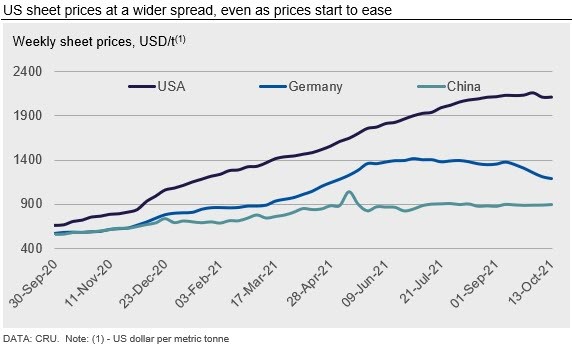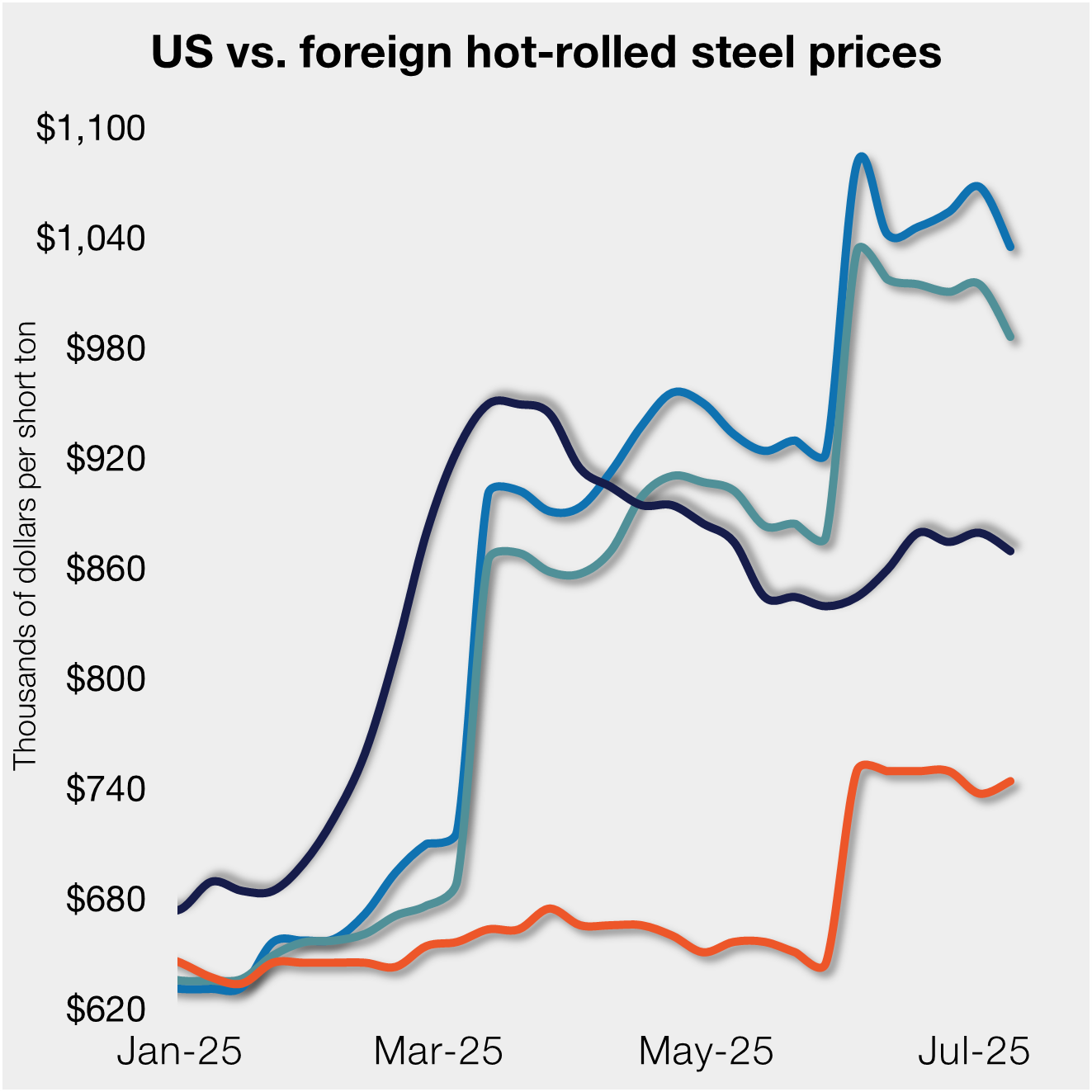International Steel Prices

CRU: After 14 Months of Gains, Global Sheet Prices Fall
Written by Josh Spoores
October 15, 2021
By CRU Principal Analyst Josh Spoores, from CRU’s Steel Sheet Products Monitor
After 14 consecutive months of rising global sheet prices, CRU’s Global Flat Products Steel Price Indicator (CRUspi flats) has fallen m/m. This indicator fell 3.5% as sheet prices continue to fall across most regional markets.

The U.S. Midwest market remains the last holdout of higher prices, yet HR coil prices are now slightly lower from our Sept. 8 assessment. On a weekly basis, HDG coil prices have also fallen back slightly while CR coil prices have made a new record high. Even with these initial declines, the price chart in this section clearly shows the widening spread between the U.S. market and others. This spread has incentivized U.S. buyers to increase their use of imports as current offers of CR and HDG coil remain around $600 /s.ton cheaper, inclusive of all logistics costs and duties.
In China, price volatility remains a prominent issue as daily sheet prices quickly picked up after the National Day holiday, yet earlier this week they eased, somewhat. The government continues to strictly enforce steel production cuts and now with the worsening energy shortage, we are picking up evidence of lower demand for sheet due to the recent power rationing. This issue of significantly higher energy costs has also affected the European market. However, while some mills are now instituting an energy surcharge, we are seeing base sheet prices fall at a quicker pace.
One other market of note is India, where monthly sheet prices have now turned higher after falling through all of 2021 Q3. This gain comes at a time of seasonal restocking, which was delayed due to the well-known supply chain issues surrounding semiconductors. However, even as this market faces their own energy shortage, higher prices here may be limited as a new blast furnace ramps up production.
Outlook: Energy Shortages Threaten Demand
In our near-term view, we continue to expect further price declines across all markets based on regional supply/demand dynamics as well as typical seasonal pressures. Additionally, we expect sheet prices to come back in line with steelmaking raw materials costs, which have also become increasingly volatile. Iron ore prices fell dramatically over the past two months, yet strong gains have been recorded thus far in October.
These recent jumps in iron ore price though have been nothing in comparison with the recent rate of increase for both coking coal and electricity. These rapid price movements may keep sheet prices at a higher rate than previously expected. However, significant gains in energy costs alongside a true shortage of supply have already led to cuts in electricity consumption at an industrial level. Due to this, we expect that sheet demand across multiple regions may now be challenged to reach previously anticipated levels. Worse, we see the increased likelihood that various materials and components will be in short supply if industrial activity is curtailed. After all, an industrial input produced in China today is required for a product manufactured in Europe or North America in the following months. Due to the shortage of thermal coal in China and record high price of LNG in most markets, we have become more concerned with what this means for industrial activity in the near term.

Request more information about this topic.
Learn more about CRU’s services at www.crugroup.com

Josh Spoores
Read more from Josh SpooresLatest in International Steel Prices

S232 tariffs keep US HR prices below imports from EU
Hot-rolled (HR) coil prices in the US ticked down this week but have fluctuated little over the past month. Stateside tags continue to trail imports from Europe, supported by Section 232 steel tariffs that were doubled in early June.

Doubled S232 tariff holds US HR prices below EU
David Schollaert presents this week's analysis of hot-rolled coil prices, foreign vs. domestic.

Higher US CR prices inch closer to EU, Japanese tags
US cold-rolled (CR) coil prices continued to tick higher this week, while offshore markets were mixed.

Stacked S232 keeps US HR prices below EU
US hot-rolled coil prices crept up again this week but still trail imports from Europe.

Doubled S232 lifts EU, Japanese CR prices over US tags
US cold-rolled (CR) coil prices edged up again this week, and most offshore markets moved in the opposite direction. But the diverging price moves stateside vs. abroad did little to impact pricing trends. The bigger impact was from Section 232, which were doubled to 50% as of June 3. The higher tariffs have resulted in […]
